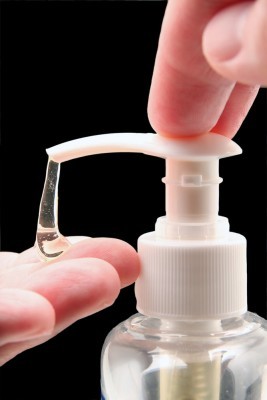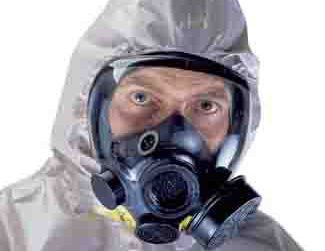 You can’t go through a checkout line in a grocery store or major discount chain without seeing them. There’s versions for kids, versions for your purse and keychain, decorative versions for around your house and of course all of the good ol’ household cleaning solutions.
You can’t go through a checkout line in a grocery store or major discount chain without seeing them. There’s versions for kids, versions for your purse and keychain, decorative versions for around your house and of course all of the good ol’ household cleaning solutions.
Nowadays, if you have an aversion to germs, you can spray them, spritz them, gel them, scrub them, mist them, zap them and wipe them away – in 2 seconds flat, even! What is it with our apparent fascination with trying to create a germ-free world? (One word: marketing)
Did you know that there are now ‘condoms’ for the handles of exercise equipment at the gym? Or cutting-edge, pocket-sized germ zappers which use ultraviolet light? How about the vacuum with the germ-destroying light? There’s even a sorta cute little hot pink apparatus called “Go Girl” to let women pee standing up when they’re out and about so they don’t have to go near the public restrooms! (Makes ya wonder exactly WHERE they will use this, but, you get the idea)
And I haven’t even TOUCHED on the subject of indiscriminate use of antibiotics by borderline-neurotic parents who demand a magic pill to kill the ‘big bad germs’ when their child has a common case of the sniffles!
Germ-Free World? Not Gonna Happen!
We must know, on the logical front, that a germ-free world is never going to happen. And we should also know by now that even if you build a stronger lock, someone will build a stronger lock cutter or learn to become a better safe-cracker.
I have to admit that I’ve never been a germaphobe. With six kids and a full-time job, I never had enough time to become obsessive-compulsive about keeping my family out of the reach of every germ which crossed our doorstep. Not that I didn’t try and keep a clean house, but I just figured that kids get dirty, get into things they shouldn’t and that a home and the world we live in are going to have their share of germs so we may as well get used to it and deal with it.
As for raising my kids on antibiotics, I don’t know about other folks, but I simply couldn’t afford to take six kids to the doc every week for prescription medication. We relied on tried and true natural remedies handed down by my grandparents for the most part. When a child truly needed a physician, that child saw a physician. But, 8 times outta 10 we could get through those childhood bouts with germs and infection without medical intervention. But are my choices, and the choices of millions of other parents like me, now a moot point?
The following article is disturbing. It is most disturbing because it suggests that this practical approach to germs, cleanliness and minor colds, flu and infection may really mean nothing. It appears that the health of my children and family, along with everyone else’s, may be seriously affected by the actions of all of the germaphobe folks out there who have a disinfectant in every room of their home, hanging from every zipper of their children’s coats, and in all of the family cars (as they race their sniffling child to the closest HMO).
We have become a culture afraid of its own world and in the process it appears that we have created the very monsters we feared.
Disinfectants May Help Superbugs Resist Antibiotics
Using disinfectants could help superbug bacteria become resistant not only to the disinfectant itself but to antibiotics, even if they have not been exposed to them, according to a new study from Ireland: the findings could be important step in the fight to prevent superbugs spreading in hospitals.
The study is the work of lead author Dr Gerard Fleming from the National University of Ireland (NUI) in Galway, and colleagues, and is available to read online in the January issue of Microbiology. Fleming heads NUI’s Marine Microbiology Laboratory, where as well as researching deep ocean microbes, he and his team investigate cross-resistance between biocide and antibiotics in human pathogens, and assess agricultural workers’ exposure to health hazards.
One of the human pathogens Fleming and his team have been invest igating is Pseudomonas aeruginosa, an opportunistic bacterium that can cause infections in people with weak immune systems, cystic fibrosis (CF), diabetes and other diseases. It is an important cause of hospital-acquired infections.
igating is Pseudomonas aeruginosa, an opportunistic bacterium that can cause infections in people with weak immune systems, cystic fibrosis (CF), diabetes and other diseases. It is an important cause of hospital-acquired infections.
There are two ways of managing hospital-acquired infections: prevention by disinfection of surfaces in the hospital, and treatment by antibiotics: what is worrying about this study is that the bacterium appears to have developed a way to foil both these routes.
Fleming and colleagues reported how by adding more and more disinfectact to lab cultures of P. aeruginosa, they found it adapted to survive not only the disinfectant itself, but also the commonly prescribed antibiotic ciprofloxacin, even without being exposed to it.
The disinfectant they used was benzalkonium chloride (BKC), a bactericide, algaecide and fungicide contained in many hospital, livestock and personal hygiene products, from surface disinfectants to skin sanitizers and cosmetics.
Fleming and colleagues found that the adapted P. aeruginosa had a DNA mutation that allowed it specifically to resist antibiotics like ciprofloxacin and that the mutated bacterial cells had become efficient at pumping out disinfectant and antibiotic agents.
Read the rest of this article here
Strengthen Your Immune System Naturally
Beta-1, 3D Glucan boosts the immune system to provide support and balance. It is unlike other immune supplements that simply stimulate or alter the immune response in unnatural ways. Over 50 years of research from prestigious universities around the world document the benefits of Beta-1, 3D Glucan.
Transfer Point is the only company that offers a Beta glucan with a minimum of 83% Beta-1,3D Glucan content, with no harmful contaminants. Every batch is independently tested and a Certificate of Analysis is provided and available upon request.
Research proves that purity matters when it comes to biological activity. No other Beta glucan can match the effectiveness that has made Transfer Point’s Beta Glucan the respected name in immune support.
Learn more about Transfer Point Beta Glucan now.
Why do we promote this?


 Fill out the form below to sign up to our free natural health and healing newsletter and stay up to date on our latest articles about holistic healing therapies and effective home remedies for common ailments. As a thank you for joining our newsletter, we’ll also send you
Fill out the form below to sign up to our free natural health and healing newsletter and stay up to date on our latest articles about holistic healing therapies and effective home remedies for common ailments. As a thank you for joining our newsletter, we’ll also send you